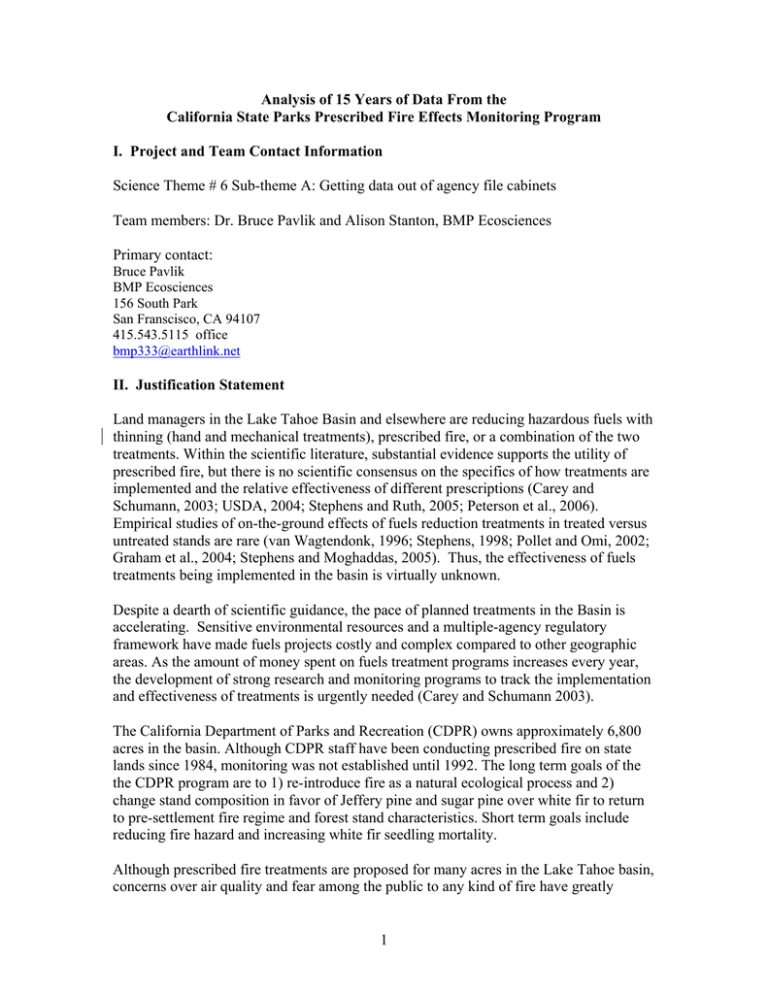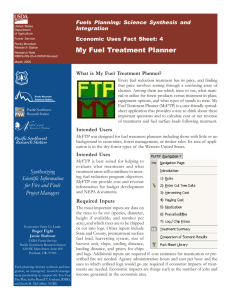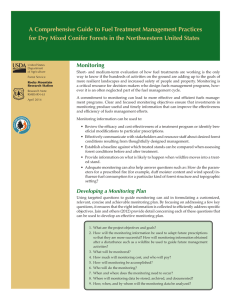Analysis of 15 Years of Data From the
advertisement

Analysis of 15 Years of Data From the California State Parks Prescribed Fire Effects Monitoring Program I. Project and Team Contact Information Science Theme # 6 Sub-theme A: Getting data out of agency file cabinets Team members: Dr. Bruce Pavlik and Alison Stanton, BMP Ecosciences Primary contact: Bruce Pavlik BMP Ecosciences 156 South Park San Franscisco, CA 94107 415.543.5115 office bmp333@earthlink.net II. Justification Statement Land managers in the Lake Tahoe Basin and elsewhere are reducing hazardous fuels with thinning (hand and mechanical treatments), prescribed fire, or a combination of the two treatments. Within the scientific literature, substantial evidence supports the utility of prescribed fire, but there is no scientific consensus on the specifics of how treatments are implemented and the relative effectiveness of different prescriptions (Carey and Schumann, 2003; USDA, 2004; Stephens and Ruth, 2005; Peterson et al., 2006). Empirical studies of on-the-ground effects of fuels reduction treatments in treated versus untreated stands are rare (van Wagtendonk, 1996; Stephens, 1998; Pollet and Omi, 2002; Graham et al., 2004; Stephens and Moghaddas, 2005). Thus, the effectiveness of fuels treatments being implemented in the basin is virtually unknown. Despite a dearth of scientific guidance, the pace of planned treatments in the Basin is accelerating. Sensitive environmental resources and a multiple-agency regulatory framework have made fuels projects costly and complex compared to other geographic areas. As the amount of money spent on fuels treatment programs increases every year, the development of strong research and monitoring programs to track the implementation and effectiveness of treatments is urgently needed (Carey and Schumann 2003). The California Department of Parks and Recreation (CDPR) owns approximately 6,800 acres in the basin. Although CDPR staff have been conducting prescribed fire on state lands since 1984, monitoring was not established until 1992. The long term goals of the the CDPR program are to 1) re-introduce fire as a natural ecological process and 2) change stand composition in favor of Jeffery pine and sugar pine over white fir to return to pre-settlement fire regime and forest stand characteristics. Short term goals include reducing fire hazard and increasing white fir seedling mortality. Although prescribed fire treatments are proposed for many acres in the Lake Tahoe basin, concerns over air quality and fear among the public to any kind of fire have greatly 1 restricted the implementation of prescribed burn programs. The CDPR monitoring effort is the only one of its kind, and the agency has been the most successful land owner implementing burns on the California side of the basin. As of 2007, 15 years of monitoring data are available but largely unanalyzed. . This dataset could greatly inform efforts to evaluate 1) the effectiveness of prescribed fire treatments in reducing the longterm (10 year) risk of wildfire and 2) the effects of prescribed fire treatments on vegetation composition, structure, and fuel loading in mixed conifer stands. III. Problem Statement CDPR has installed a total of 87 monitoring plots from 1992 to 2004 on State Park properties along the west shore of Lake Tahoe.. As of 2006, there are 10 year post-fire data from prescribed burn treatment plots. A portion of the monitoring data from three years post-fire has been previously analyzed to evaluate specific short-term effects of prescribed fire in mixed conifer stands (Madeno, 2000). We propose to expand the analysis of this dataset to examine a greater range of short and long-term effects of the treatments and to evaluate the effectiveness of the monitoring program itself. In the three year post-treatment analysis, Madeno (2000) used data from 28 plots to draw several conclusions regarding fuel loading in both white fir-dominated and pinedominated stands. She found immediate (1 yr) post-fire reductions in average fuel loads of 75% in white fir and 56% in pine stands. Coarse woody debris (CWD), a significant indicator of wildlife habitat quality, was reduced by 49% in the fir-dominant and 69% in the pine-dominant plots. Over the three years post-fire, total average fuel loads accumulated at approximately 1kg/m2/yr in both monitoring types. At that rate, it would take 9-15 years to reach pre-fire fuel loadings. No significant changes were detected in the canopy cover or basal area of overstory trees but three year post-fire data showed a significant reduction in live overstory tree density. Significant changes were also detected in live pole-sized tree density. Herbaceous cover and species richness increased following prescribed fire only when the event was great enough to induce significant mortality in the tree canopy. These analyses need to be continued to include data collected over the last 6 years and synthesized to make the results more relevant to current management concerns. CDPR has experienced many staffing changes in that time. Consequently, there is currently no personnel with the experience or time to conduct the needed analyses and to develop revisions to the monitoring program. The monitoring program has been inadequately funded and there is a strong incentive to justify the cumulative investment and either make improvements to the existing program to make it more efficient and effective or develop a new program. In the absence of such justification there is a potential that CDPR could abandon the program altogether. CDPR staff strongly supports this proposal and has agreed to make the entire dataset (database, original data sheets, maps, and collection protocols) available to our team (T. Sasaki and N. Lozano, pers comm. 2007). Scheduled data collections for 2007 will also proceed. In addition, the developer of the monitoring program and author of the three year post-fire analysis, although no longer a 2 CDPR employee, has agreed to provide any needed clarifications of the data set (E. Madeno, pers comm., 2007). IV. Goals, Objectives, Hypotheses The main objective of this study is to analyze the existing CDPR dataset to evaluate the effects of prescribed fire treatments on vegetation composition and structure, fuel loading, and potential fire behavior in mixed conifer stands. The collected data can be used to address the following Key Management Questions (KMQs): 1) What is the effect of fuels treatments on the rate and direction of forest succession, fuel loading, and fuel configuration compared to not treating at all? 2) How effective are prescribed fire treatments in altering fire behavior, improving suppression effectiveness, and reducing fire severity under the range of fireweather conditions likely in the Lake Tahoe Basin? 3) Do prescribed fire treatments change the balance of native or non-native understory vegetation? One of the project-level objectives of the CDPR prescribed fire program is to reduce total fuel loads by 60% while maintaining a reasonable portion of the pre-fire fuel load of coarse woody debris (CWD) in the 1,000 hour timelag class. Hypotheses related this objective and to the above KMQs can be addressed including (but not limited to): 1) Do fire severity and pre-fire duff depth affect post-fire CWD fuel loads? 2) How does the rate of surface and fuels ladder accumulation vary with canopy cover or tree mortality after prescribed fire treatments? 3) Is there a difference in post-fire regeneration of white fir seedlings in white-fir and pine-dominated mixed conifer stands? A secondary objective is to evaluate the effectiveness of the CDPR fire monitoring program and provide recommendations for future monitoring efforts. Our team will use the results of the data analysis and input from CDPR staff to develop a set of KMQs specific to CDPR and an adaptive management program. The program will be designed to provide data that will best answer the KMQs given limited staff resources. V. Approach, Methods, Location The CDPR Fire Effects Monitoring Program installed 87 plots in the period from 1992 to 2004, with monitoring continuing to the present. These plots are distributed throughout 5 park units (Burton, DL Bliss, Sugar Pine Point, Emerald Bay, Plumas, and Malakoff) located on the west and north shore of the Lake Tahoe Basin. The units are dominated by mixed conifer forests of red and white fir, Jeffrey pine, sugar pine, and incense cedar. Of the 87 plots, some plots have been maintained as controls, but many of the plots have never been treated. Data collection for the program has followed protocols in the Fire Monitoring Handbook (FMH), developed by the National Park Service (USDI 1992). As 3 part of the protocol, each unit is described by a monitoring type that is defined by the dominant vegetation and assigned fuel model (NFFL fuel modeling system- Anderson 1982). A preliminary evaluation of the dataset suggests that approximately 36 plots in 6 different monitoring types have data that can be analyzed by the end of 2007 (Table 1). Table 1. The number of treated and control plots available for analysis from the CDPR prescribed fire monitoring program in 2007 (including plots scheduled for monitoring in 2007. A monitoring type is defined by the four letter species code (common name is in parenthesis) and the fuel model number. Monitoring type # treated plots # controls ABCO9 (white fir) 21 5 ABCO8 (white fir 1 1 ABMA10 (red fir) 1 0 PIJE5 (Jeffrey pine) 2 1 PIJE9 (Jeffery pine) 3 0 PILA9 (sugar pine) 1 0 Total 29 7 The majority of the plots were initially installed in 1992-1993 and burned in 1995. A few plots were burned later in the season in the same year of installation, but the monitoring schedule specifies a post-fire monitor the year following the burn and then again 1,2,3, 5,8, and 10 years post-fire. The earliest burn was conducted in the fall in 1992 and latest was in fall 2007. Burn severity was measured on a qualitative scale from 1-5, with 1 indicating high severity. CDPR staff will conduct scheduled 10 year post-fire data collection in 2007 in three ABCO10 and one ABCO8 plots. Additional plots will be monitoring as recommended by our team: we have identified one control plot in ABCO8, 2-3 plots in ABCO10, and one in PIJE5 that could serve as useful controls if monitored in 2007 (not included in the counts in Table1). Data Analysis Fuel loading for each time-lag class was collected using a modified planar intercept method (FMH 1992) for the following variables: litter and duff depth, 1-hour, 10-hour, 100-hour, and 1000-hour stick counts. Collected overstory tree (>15 cm dbh) data included: species, dbh, canopy crown position, damage, post-fire char height, scorch height, and scorch percent. Pole-sized tree (>2.5 cm < 15 cm dbh) data included species, height, and dbh. All overstory and pole-sized trees were tagged and mapped. Herbaceous species and cover were recorded with a line-intercept method and shrub species and cover were tallied as mature, re-sprout, or seedling along a belt transect. Pre-treatment vegetation structure and fuel loadings will be re-analyzed to determine appropriate groupings of treated plots and pairing with controls. In white fir (ABCO9) it 4 will be possible to a use a paired approach of treatment-control plots to determine significance of post-fire treatment effects. For other groupings of treated plots, pre- and post-treatment years will be tested for significant differences using analysis of variance (ANOVA) (p < 0.05) or the appropriate non-parametric tests. If significant differences are detected, a Tukey-Kramer HSD test would be performed to determine if there were significant differences between treatments. Logistic regression models will be performed to determine correlation between post-fire tree mortality and first order fire effects. For each time step (pre- and pos-t), fire behavior will be modeled under three fire weather conditions using Fire Family Plus and Fuels Management Analyst (FMA). VI. Deliverables We expect the results of the study to directly inform the design and implementation of the CDPR fire monitoring program. Results from this unique and valuable dataset will provide much needed information on both the short (<3 yr) and long-term (10 yr) effects of prescribed fire treatments in mixed conifer forests along the west shore of Lake Tahoe.. Deliverables include: • Final report on the fire effects monitoring data • CDPR Fire Effects Monitoring Program recommendation report • Presentation at a regional scientific meeting, and to local managers. • Peer-reviewed publication VII. Schedule This project will be completed in time to inform the CDPR monitoring program in 2008. Activity Completion Date Data analysis and preliminary report Sept 2007 CDPR data collection on 4-8 plots Sept 2007 Update analysis with additional data and submit final report Dec 2007 2008 monitoring program recommendations March 2008 5 Literature Cited Anderson, H.E. 1982. Aids to determining fuel model for estimating fire behavior. GTR INT-122. Ogden, UT: USDA, Forest Service Intermountain Forest and Range Experiment Station. 130 p Carey, H. and M. Schumann. 2003. Modifying wildfire behavior- the effectiveness of fuel treatments: the status of our knowledge. Southwest Region Working Paper 2. Sante Fe, NM: Forest Trust, National Community Forest Center. 26 p. Graham, R.T; McCaffrey, S. and T.B. Jains. Eds. 2004. Scientific basis for changing forest structure to modify wildfire behavior severity. RMRS-GTR-120. Fort Collins, CO. USDA, Forest Service, Rocky Mountain Research Station. 43 p. Mandeno, P.E. 2000. Prescribed fire effects in mixed conifer stands in the Lake Tahoe Basin, CA. University of Nevada, Reno. Unpublished Master’s Thesis. 60 p. Pollet J. and P. N Omi. (2002) Effect of thinning and prescribed burning on crown fire severity in ponderosa pine forests. International Journal of Wildland Fire 11, 1–10. Stephens, S.L. 1998. Evaluation of the effects of silvicultural and fuels treatments on potential fire behavior in Sierra Nevada mixed conifer forest. Forest Ecology and Management 105:21-35. Stephens, S. L., and J. J. Moghaddas. 2005. Fuel treatment effects on snags and coarse woody debris in a Sierra Nevada mixed conifer forest. Forest Ecology and Management 214:53-64. Stephen, S.L and L.W Ruth. 2005. Federal forest fire policy in the United States. Ecological applications 15:532-542. US Department of Agriculture, Forest Service; US Department of Interior [USDA USDI]. 2001. National Fire Plan. A report to the President in response to wildfires of 2000. Van Wagtendonk, J.K. 1996. Use of a deterministic fire growth model to test fuel treatments. In: Sierra Nevada Ecosystem Project: final report to Congress, volume II. Davis, CA: University of California, Centers for Water and Wildland Resources. 11551165. 7





